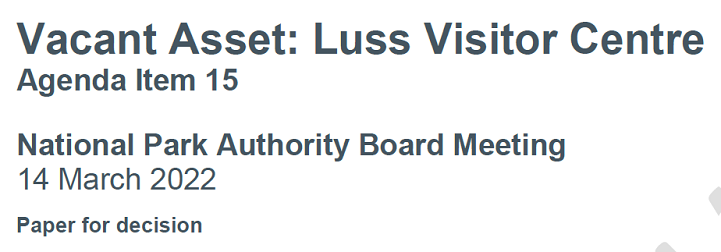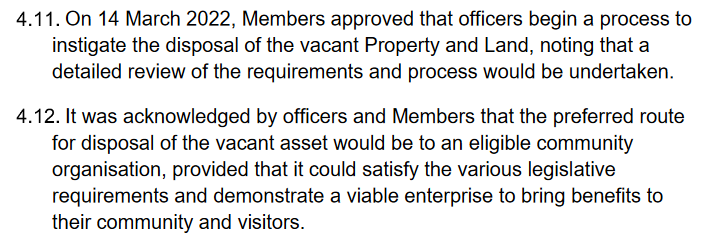This post take a further look (see here) at the Loch Lomond and Trossachs National Park Authority (LLTNPA)’s attempt to sell off its Visitor Centre at Luss, in the light of the discussion and decision made at the Board Meeting on 26th September and responses to Freedom of Information Request (FOI)s. I argue that the evidence suggests the actions of the LLTNPA to date betray a lack of moral compass and are contrary to Scottish Government Policy, as set out in Scotland’s Land Rights and Responsibilities Statement, which was laid before the Scottish Parliament in 2017.
Unwarranted secrecy
On the agenda (see here) for the LLTNPA’s March Board Meeting was an item entitled “Luss Visitor Centre update” scheduled for discussion in confidential session.
I have now, through FOI requests, obtained a redacted copy of the paper discussed by the Board (see here) and the minute for the meeting (see here) . This shows that while the LLTNPA Board were indeed given an update – about the failed tender process to find a new tenant for the visitor centre – they were also asked to make a decision.

So why did the LLTNPA want to hide from the public what they were really doing?
That decision, taken in secret, was “to approve that officers begin a process to instigate the disposal of the vacant Luss Visitor Centre”. The minutes for the meeting are marked CONFIDENTIAL so it clear that, at the time, the LLTNPA did not want the public to know what they had decided.
The law on such decisions, though complex to follow, is clear in intent and referred to in the LLTNPA’s standing orders (see here): it is the Board that makes decisions and, “subject to any legislative provisions allowing exclusions of the public, Board meetings must be open to the public”. The exceptions are governed by Section 50 of the Local Government (Scotland) Act 1973 which requires public authorities to pass a resolution stating WHY any part of a meeting should take place in private. The full minute of the March Board Meeting states that the LLTNPA passed a resolution to exclude the public from the Luss Visitor Centre update item but does not record the reason why.
While the redacted sections of the March Board paper may contain information that it was legitimate for the LLTNPA Board to consider in private, for example Schedule 7A to the 1973 Act exempts “Any terms proposed or to be proposed by or to the authority in the course of negotiations for a contract for the acquisition or disposal of property…………”, it also contained information and proposals that should have been discussed in public.
It appears that the LLTNPA’s officers subsequently realised this because para 4.9 of the September Board Report states “Considering the commercially sensitive information included in the March Board report, this item was considered in a publicly excluded part of the meeting”. What the September paper didn’t say was that because the March paper contained other information relating to the recommendation to dispose of the Visitor Centre, the decision should have been taken in public and as a consequence was probably open to legal challenge.
Hence why the first recommendation in the September Board paper was remarkably similar to that put to the March Board meeting: “Approve that officers proceed with the process to dispose of the vacant asset in Luss”.
There is nothing in the paper or the minutes for the March Board Meeting to say that officers, having been given authority to “instigate” the process to dispose of the Luss Visitor Centre, required to come back to the Board for further permission to “proceed”. The LLTNPA Board has, therefore, effectively been asked to take the decision to dispose of the Luss Visitor centre twice, the first unlawfully and in secret, the second to legitimate the decision.
It is worth noting here Principle 5 from the Scottish Land Rights and Responsibilities Statement (see here)

While this principle is far from comprehensive and quite wishy washy (“there should be improved transparency” could mean almost anything) the explanatory text does say:
“Information about land and buildings provides the foundation for open and transparent decision-making by public and private sector organisations, communities and individuals. Provision of information can also enable participation, which is a key element of the human rights framework.”
It is very clear that the LLTNPA’ initial decision to dispose of the Luss Visitor Centre was neither open nor transparent.
Ticking boxes while sidelining the local community
Unfortunately, while Part 8 of the Community Empowerment (Scotland) Act 2016 creates a legal duty on public authorities to consult local communities before disposing of Common Good land, it does not require them to proactively consult before selling off other land or buildings. The legal onus is on local communities to register interests in such land and there was nothing therefore in the law that required the LLTNPA to engage with the local community in Luss before deciding to sell off its visitor centre there.
It might appear positive therefore that when deciding to instigate the process to dispose (sell) Luss Visitor Centre in March, the LLTNPA Board also agreed staff should explore local interest in a Community Asset Transfer (CAT). What Board Members did not appear to appreciate is that under Community Asset Transfers communities have a right to lease properties so, if the LLTNPA were serious about this option, the decision to dispose of the Visitor Centre was premature.
There is nothing either in the March Board Paper or Minute to suggest that a CAT was the preferred route for disposal of the Visitor Centre despite the claim made in the September Board Paper:

The first paragraph is correct but the second appears to have been completely fabricated with no evidence to back it up. What the March paper did say is that:
“There is also likely to be interest in the property for a Community Asset Transfer, which while may result in potentially protracted negotiations and use considerable resource to manage, it may also present an attractive option in order to realise positive uses for the building and deliver community benefit“.
The discussion at the September Board Meeting, which I observed and noted, supports my contention (see here) that the LLTNPA had no real intention of supporting a CAT. Staff failed to answer questions from the new locally elected member for the area, Sid Perrie, about why they had rejected the CAT submitted by the Luss and Arden Community Development Trust in June (see here). Sid Perrie persisted and the Convener James Stuart tried unsuccessfully to shut him up (three times by my count) before revealing that the reason was that a clause in the CDT’s constitution did not meet legal requirements.
This should have been simple to change but rather than giving the CDT time to do so, officers recommended the LLTNPA should proceed with a sale on the open market. In the course of the discussion about this the Convener, James Stuart, made two revealing and misleading claims. The first was that it is “up to them to adjust” their constitution and “we cannot tell a local community how to constitute themselves”. This ignored the fact that the LLTNPA was actively involved in supporting local communities in the National Park to set up local Community Development Trusts with constitutions which it has subsequently turned out were not fit for purpose! Other local community development trusts takenote!
Second, after stating he was frustrated and “we have to believe our team”, Mr Stuart claimed the CDT had had six months to work on the CAT. This cannot be true if the the CDT was approached after the March meeting as they submitted the CAT in June. That the real agenda of the LLTNPA might be different to what is being said in public was further suggested by James Stuart’s remark, that appeared expressed out of frustration, that “We’ve delayed and delayed and delayed”. No wonder Mr Stuart doesn’t want recordings of Board Meetings to be in the public realm!.
In policy terms, the comments made by Mr Stuart appear contrary to the principles in the Scottish Government’s Land Rights and Responsibilities statement, two of which are about local communities:
“3. More local communities should have the opportunity to own, lease or use buildings and land which can contribute to their community’s wellbeing and future development.”
“6. There should be greater collaboration and community engagement in decisions about land.”
It seems that, like Forest and Land Scotland at Glenmore (see here), the LLTNPA believes the Scottish Government’s policy statements on the need for community empowerment in respect to land are not worth the paper they are written on.
What needs to happen?
While piles of policy papers are easy enough to ignore, public opinion is another matter and I have heard enough to know that the LLTNPA are concerned by the local reaction and have re-started engagement with the Community Development Trust. It is too early to tell if that engagement is in good faith but if people in the local community are determined enough, they may still be able to takeover the Luss Visitor Centre.
The argument, however, still needs to be made that the LLTNPA should support this. While staff made the welcome acknowledgement at the meeting they have neither the skills nor the time to manage commercial tenants – quote “it’s not what we do” (effectively an admission that the LLTNPA’s commercial strategy, in which it tried to increase income by renting out its properties has been a complete flop) – the solution as they see it is to sell off “surplus” property, a blinkered view. This effectively means the LLTNPA is ignoring its moral obligation to support local communities even though this may put demands on staff time and result in ongoing financial commitments.
I will come back to the case for supporting the local community at Luss in a future post but its worth considering briefly how the LLTNPA got itself into this mess. Part of the problem I believe is there is a long history of the LLTNPA covering up its property failures by discussing the issues in confidential session – it has never for example openly revealed or analysed the losses it has incurred through various failed leases. For example, Luss Visitor Centre was also discussed in confidential session in June 2021. What this means is that the focus of the LLTNPA Board has been on the finances, not on the potential use of its assets and the wider public interest.
There are signs that some LLTNPA members appreciate this is wrong. For example Ronnie Erskine, who voted against the disposal at both Board Meetings questioned why the LLTNPA would even consider selling off the Visitor Centre before it had completed or the Board approved its estates strategy (forthcoming apparently!).
This focus on finance is reinforced by the Scottish Government’s Public Sector Finance Manual, quoted extensively in the September Board Report, which puts money first and ignores the wider public and community interest. That is unlikely to change unless the Scottish Government changes the law to require Public Authorities to consult publicly about the future of land and assets which they believe are surplus to requirements BEFORE any decision to declare them surplus is made.

Could someone explain why commercial contracts are not disclosed. Transparency is the easiest way to stop any corruption
It is because the law is designed to protect commercial interests including interestingly the “commercial interests” of public authorities. That helps explain why they operate now more like corporations than agencies owned by the public and supposedly service the public interest.